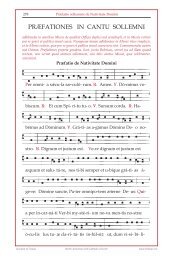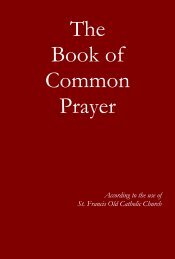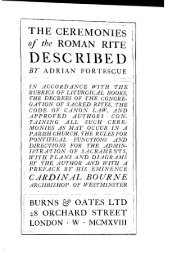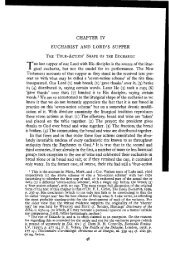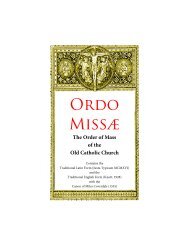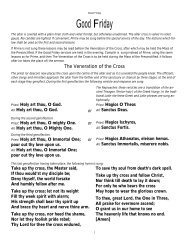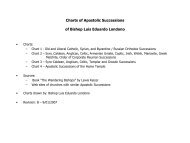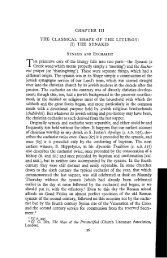Official Record of Apostolic Succession of
Official Record of Apostolic Succession of
Official Record of Apostolic Succession of
You also want an ePaper? Increase the reach of your titles
YUMPU automatically turns print PDFs into web optimized ePapers that Google loves.
The <strong>Apostolic</strong> <strong>Succession</strong> from<br />
Iglesia Filipina Independiente<br />
(The Philippine Independent Catholic Church)<br />
With a membership well in excess <strong>of</strong> one million members, the Iglesia Filipina Independiente has long<br />
been considered one <strong>of</strong> the largest Catholic jurisdictions not under obedience to Rome.<br />
Sometimes called the "Aglipayan" Church, this national Church is the daughter Church <strong>of</strong> The Roman<br />
Catholic Church <strong>of</strong> The Philippines rather than a result <strong>of</strong> the movement to restore Orthodoxy to the<br />
Occidental Church <strong>of</strong> Europe during the Middle Ages. Her history, however, is firmly linked to the history <strong>of</strong><br />
Spain.<br />
Almost four centuries ago the power <strong>of</strong> Spain overshadowed all other European nations in the Americas. In<br />
the same year that Cortes conquered Mexico, Magellan discovered the Philippines in the Pacific - which<br />
Spain governed, robbed, and oppressed for three hundred and seventy-five years (until she lost control on<br />
May 1, 1898, when the U.S. fleet, under Commadore George Dewey, sailed into the Bay <strong>of</strong> Manila and won<br />
a victory as complete and astonishing as that <strong>of</strong> Cortes in Mexico).<br />
Spain's misrule in her colonies (Magellan began his rule in The Philippines by decapitating the beloved<br />
native ruler) produced a chronic state <strong>of</strong> insurrection; one after another, her colonies slipped from her grasp<br />
(Peru, Bolivia, Colombia, The Argentine, Mexico, Louisiana, Florida, and the greater part <strong>of</strong> the East Indies).<br />
She ceded Louisiana to France in 1800, Florida to the United States in 1819, and a few years later Mexico<br />
achieved her independence. Yet Spain still had the rich islands <strong>of</strong> Cuba and Puerto Rico in the West Indies<br />
and The Philippines in the East Indies; but these were quickly lost after her humiliating defeat by the<br />
Americans.<br />
Just as the Spanish colonial government had oppressed the Filipino people, so also the Church <strong>of</strong> Rome<br />
(thru the rule <strong>of</strong> the local parishes by the Friars) greatly oppressed the native population. When Commadore<br />
Dewey won The Battle <strong>of</strong> Manila and occupied the city, he had to set up an American defense force to<br />
protect the former Spanish colonial rulers (civil and religious) and allow them to leave the islands. The<br />
National Philippine Militia was at the gates <strong>of</strong> Manila and had vowed to kill all Spaniards. Commadore<br />
Dewey was later commended by most European powers for the honorable way in which he had handled this<br />
matter.<br />
It was not that The Church <strong>of</strong> Rome and Her clergy, even the Friars, had worked in vain. The native<br />
population had been brought the hope <strong>of</strong> The Gospel, which survives today in the vigorous folk devotion in<br />
the villages and the equally vigorous intellectual life <strong>of</strong> the larger cities <strong>of</strong> The Philippines.<br />
Never the less, the Spanish colonial system, which identified The Church <strong>of</strong> Rome with the <strong>of</strong>ficial colonial<br />
government (State), had put into the hands <strong>of</strong> the religious a tempting power which bore seeds <strong>of</strong> abuse and<br />
corruption. By the nineteenth century, the Spanish Friars enjoyed such a suffocating monopoly on farmland<br />
that they became the main target <strong>of</strong> the revolutionary literature which finally united the Filipino people in<br />
armed rebellion in 1896.<br />
Within the Church <strong>of</strong> Rome in The Philippines, the Filipino clergy agitated against the arbitrary power <strong>of</strong> the<br />
foreign Friars. They also suffered from what might be called "racial discrimination" in that native clergy<br />
always occupied second-rate positions, and none were ever elevated to the episcopal rank.<br />
In 1872 three native priests were executed for taking an anti-friar stand, an act not forgotten by the native<br />
clergy.<br />
But Commadore Dewey's arrival in Manila Bay revived the stalemated native Filipino-Spanish hostilities.<br />
After the Battle <strong>of</strong> Manila and the occupation <strong>of</strong> Manila by Dewey, Father Gregorio Aglipay (<strong>of</strong> Illocos Norte)<br />
was appointed Vicar General <strong>of</strong> the Revolutionary Army by General Emilio Aguinaldo. In addition, the<br />
Spanish Bishop Jose Hevia Campomanes, a prisoner <strong>of</strong> the Filipino forces, named Fr. Aglipay the<br />
Ecclesiastical Governor <strong>of</strong> Nueva Segovia, a huge Episcopal See covering all <strong>of</strong> Northern Luzon.



